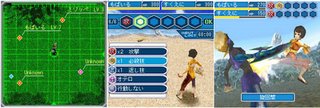Wednesday, May 24, 2006
EZChaku-utafull exceeds 50 million downloads
EZChaku-utafull, the branded Chaku-utafull service offered by Japanese operator au, exceeded 50 million downloads on May 20th this year according to a press release from KDDI today.
EZChaku-utafull tracks are currently available from 80 EZweb sites with a combined catalogue of over 150,000 tracks and 20,000 tracks are also available on au’s PC-based LISMO Music Store since its launch earlier this month.
The service was launched in November 2004 and recorded 1 million downloads by January 2005. The rate of growth has accelerated, with 5 million downloads recorded by April 2005 and 10 million downloads by June 2005.
Monday, May 22, 2006
au reveals summer collection 2006
Following announcements last week from DoCoMo and Vodafone KK, au today announced its summer 2006 handset lineup.
The operator revealed details of 6 CDMA2000 handsets and 1 CDMA1X handset for release this summer. Casio will release the G’zOne W42CA, a ruggedized, waterproof handset which nods towards the company’s G Shock watch collection. There are also handsets optimised for use as mobile music players – notably the W42S “Walkman Keitai” by Sony which boasts 30 hours playback time – but this time round all are flash memory based and there are no harddisk players like the W41T handset from au’s spring collection. There are handsets supporting digital Oneseg and analogue mobile TV.

Friday, May 19, 2006
Bluetooth multiplayer games hit Japan
Sharp’s new 905SH, which goes on sale on the Vodafone network on the 27th May comes with 17 pre-installed applications – 8 of which are multiplayer games using Bluetooth to connect players. It is the second phone to support ChikaChat (a Bluetooth chat application for 1-8 people) and ChikaGame (multiplayer Bluetooth games) following the 904SH which went on sale on April 15th.
The games are mainly a mixture of sports titles including “EX Baseball Miracle Battle” and “Max Power Air Hockey” and old favourites such as “Super Bomberman BT”, “Meteos Mobile”, “Arkanoid Link” and “Battle Pacman”. “Asphalt Urban GT2” and “Battle Game Pack” complete the lineup.
ChikaChat and ChikaGame were announced as part of Vodafone’s new strategy for 2006 before it was bought up by Softbank. With Softbank announcing a tie-up with Vodafone to produce new handsets and services, it looks like ChikaChat and ChikaGame will feature on Softbank Mobile handsets in the future.


Thursday, May 18, 2006
New brand name for Vodafone Japan announced
After much speculation it was announced today that the new brand name for Vodafone KK will be … Softbank Mobile. Logos, retail outlets and marketing material will all be rebranded, with Softbank citing the target date of October this year for completion of the process.
In other Vodafone news, the network has begun to release details of its summer lineup. Interestingly Vodafone is continuing to push prepay in a market which just does not seem to want it – announcing the V201SH, a pretty dull-looking prepay-only handset. Vodafone doesn’t release prepaid subscriber figures for Japan but as of April 2006, DoCoMo had 51,000 prepaid customers and au 288,000, tiny percentages of their overall subscriber bases.

Monday, May 15, 2006
Camera-based search for mobile launched
D2C and Bandai Networks last week announced the commencement of their “Camera Search” service.
The service allows consumers to search for information and buy items such as CDs and mail order goods simply by taking a picture of the item in question and sending it to a server employing image recognition technology called ViPR developed by American firm EvolutionRobotics. For example, the consumer can take a picture of a CD jacket and receive artist news and buy the CD directly on their phone from retailers such as Amazon and Tower Records. The service will initially support searches for five types of images – CD jackets, wine labels, mail order catalogues, magazines and adverts.
The “Camera Search” application will also come pre-installed on DoCoMo’s N902iS – one of the new handsets in the operator’s summer collection revealed last week.
Friday, May 12, 2006
More information on DoCoMo's summer lineup
More information is beginning to come out on DoCoMo’s summer lineup of 10 new 3G handsets announced yesterday.
The SO902iWP+ is the first FOMA handset to feature water proofing and can be completely submerged in water 1m deep for up to 30 minutes. The DOLCE SL ‘luxury handset’ is covered with synthetic leather. The SA702i includes a digital compass which works together with its GPS functionality to power it’s ‘pedestrian navi’ application software.
Many of the handsets are big on music playback capability, presumably in preparation for the launch of a DoCoMo music service to rival au’s LISMO!. The N902iS supports SD audio playback and features 1gb of onboard memory and the SH901iS contains a battery which lasts for 22 hours of continuous playback.
27th Carnival of the Mobilists - hosted at The 3G Portal
Thursday, May 11, 2006
DoCoMo announces 10 new 3G phones
Highlights include the F902iS which boasts WMA playback, Chaku-Moji and a biometric fingerprint scanner, the N902iX High-Speed – Japan’s first HSDPA handset and the SO702i which comes with a choice of three fascia sets – Nordic, London and Japan.



Wednesday, May 10, 2006
Has i-mode 'made it over here'?
Two weeks ago, I attended a panel discussion event organised by BIMA in
Perhaps due to the nature of BIMA’s activities, the majority of attendees were from creative agencies rather than from mobile backgrounds. One such attendee was a relative newcomer to mobile and asked me before the event started what i-mode actually was – was it a special technology? A new type of phone? Or just a brand name?
This seemed to be an image shared by many people there - that i-mode was something tangible that could be easily taken from
When I lived in
There is also cooperation between MNO and content providers which had noticeable benefits for the consumer experience. When I went mobile shopping on Amazon, the goods would automatically be shipped to my phone’s registered address and added to my monthly mobile bill. When I wanted to download a game, the portal I accessed would automatically be able to tell whether my phone was compatible and again bill my mobile account for the cost of the game.
The real value of i-mode is not in its technology, nor is it in its brand name – it’s in the ecosystem that DoCoMo has created around the platform and the noticeable benefits this brought to the mobile consumer experience. This has yet to be recreated by any of the non-Japanese operators who have donned the i-mode brand and is the reason that, for now, i-mode still hasn’t ‘made it over here’.
Monday, May 08, 2006
Mobile football game lets players make teams with their friends
The game itself is single player, but Tecmo have given it a social element – players can add download characters created by their friends and add them to their football team. Characters can also be traded with other players with the aim of creating “the world’s strongest football team”.
“Kicking Buddies” is charged by monthly subscription at ¥315 (around $2.80) per month.
For a free mini-report on mobile games in Japan, click this link.
Friday, May 05, 2006
Square Enix launches team battle mobile MMORPG
The new functionality means that players can invite friends to join their team or make new team-mates with players met in the game and fight against other teams of 3 real human players in realtime.
The billing system for Code Age Brawls is monthly subscription of 525 yen per month (around $4.60).
Find out more about the Japanese mobile games market with Wireless World Forum's free mini-report.

Thursday, May 04, 2006
Phone’s reception affects your ninja powers in new game
The game involves sneaking around buildings, avoiding enemies and traps and searching for hidden ninja treasures. The player controls a ninja whose field of vision is directly affected by the current level of reception on the phone. Where reception is good, the field of vision is good, but as reception weakens, so does your ninja vision which makes it much more difficult to avoid traps and find treasure. The game costs 105 yen (around $0.90).
For more information about the Japanese mobile games market, download Wireless World Forum's free mini-report – mobile games in Japan.
Tuesday, May 02, 2006
Family plans and loyalty schemes most effective churn-reducing tool?
Last week, Japan’s Ministry of Home Affairs announced the results of a public survey they undertook on Japan’s telecoms industry. The ministry is playing a large role in the introduction of Mobile Number Portability (MNP) to Japan this autumn, and, unsurprisingly, there were several questions aimed to gauge the public’s views on changing operators.
When asked whether they wanted to change carriers, 23% of respondents said that they did, with the top factors cited for choosing operator being discount plans (39.9%), coverage (39.2%) and data transmission charges (28.5%).
More interestingly, when asked what factors put them off moving networks, the fact that it was a nuisance to change number was not the top reason, coming in second place with 25.1%. The top answer with 34% of responses was that subscribers wanted to keep on using their family plans and contract-length related loyalty discounts. It still surprises me that such schemes are not used more often by operators outside of Japan as a method of reducing churn.






